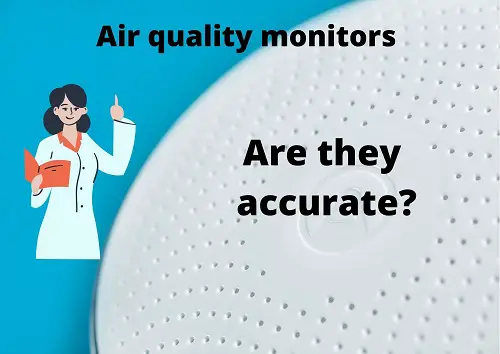Air quality monitor measurements for particulate matter, VOCs and CO2 are generally within 10% of the actual value. Measurement accuracy generally improves from <10% off to <5% off after the initial calibration period of approximately 2 months. Temperature differs no more than 0.5°C and relative humdiity differs no more than 3% from the actual value. The exact accuracy is different for each monitor.

So you are considering purchasing an indoor air quality monitor. How do you know its reading will be an accurate estimation of exactly what is in your air?
To answer this question, I studied the available scientific literature as well as the accuracy mentioned in the user manuals of several monitors.

Commercial air quality monitors are surprisingly accurate
Several studies have tested whether cheap commercial air quality monitors can compete with high-quality scientific measuring instruments. Surprisingly, they come very close, often within 10% of the actual value.
Unfortunately, some of the monitors that were tested in these studies are no longer available. However, I think it is safe to assume that air quality monitors get better and better. Therefore, the latest air quality monitors are likely to outperform any of the monitors that are no longer available.
The following table shows which monitors were tested in these studies and what was concluded based on the results.
| Study | Tested monitor | Tested compounds | Conclusion of study | Flaws of tested monitor(s) |
|---|---|---|---|---|
| Field evaluation . . . residential environments. 2018 (source) | Foobot | • Temperature • Relative humidity • Total volatile organic compounds (tVOC) • Carbon dioxide (CO2) equivalents • Fine particulate matter (PM2.5) | “low-cost monitors . . . have the potential to identify high pollutant exposures and to provide high-density, reliable, temporal data . . .” | • Temperature was underestimated by 2.59 ∘C. • CO2 measurements are not accurate. |
| Evaluation of . . . reproducible platform. 2021 (source) | uHoo | • CO2 • TVOC • PM2.5 | “Differences in the readings of sensors placed in the same location did not exceed 5%.” | • PM2.5 sensors were limited by a minimum reading of about 4.8 μg/m3. |
| Performance assessment . . . thermal conditions. 2020 (source) | • AirVisual Pro • Awair 2nd Edition • Clarity Node • Foobot • Kaiterra Laser Egg • uHoo •Netatmo | •Temperature • Relative humidity • CO2 • TVOC • PM2.5 | • Most of the tested units can be used for measurement-based IAQ and comfort management. • Awair 2nd Edition scored highest overall accuracy in measuring multiple environmental parameters among the low-cost units. • Price of the low-cost monitors does not scale with their performance. | • Foobot and uHoo monitors failed to accurately report the CO2 concentration • “tendency to over-report relative humidity in cool and dry conditions and under-report it in warm and humid conditions.” • “End-users should be made aware that the PM data from the current low-cost sensors needs to be understood as an indication of a state change or a rough estimation rather than actual concentration in indoor environments.” |
Table 2 shows the accuracy of several air quality monitors according to their user manual or product specification by the manufacturer.Air quality monitor Accuracy (based on user manual) Airthings Wave Plus
(source)• Temperature ∓ 0.1°C / F
• Humidity ∓1%
• Pressure ∓0.15hPa
• Radon: first 7 days < 10% off,
after 2 months < 5% off
• tVOC: unknown (“settling time of ~7 days”)
• CO2: ±30ppm ±3% within 15 – 35°C
/ 60 – 95°FAirthings View Plus
(source)• Temperature: ±0.5 °C / ±1 F
• Humidity: ±3%
• Pressure: ±0.6 hPa
• Radon: After 7 days ~ 10 %,
After 2 months ~ 5 %
• Particulate matter (PM2.5):
below 150 μg/m³: ± (5 μg/m³ + 15%),
above 150 μg/m³: ± (5 μg/m³ + 20%)
• VOC: Unknown (“Self-calibrated using an
automatic baseline algorithm that
updates continuously based
on the cleanest air the sensor is exposed to”)
• CO2: “±50ppm ±3% within 10 – 35°C
/ 50 – 95°F and 0 – 80% relative humidity, after initial
calibration time of 7 days
Self-calibrated using an automatic baseline
algorithm that updates once a week”uHoo
(source)• Temperature: ±0.5 °C
• Relative humidity: ±3% of actual value
• Air pressure: ±1 mBar
• CO2: ± 5% of actual value
• PM2.5: ±10% of actual value
• Carbon monoxide: ±5% of actual value
• VOCs: ±10% of actual value
• Nitrogen Dioxide (NO₂): ±10% of actual value
• Ozone (O₃): ±10% of actual valueAwair Element
(source)• Temperature: ±0.2°C
• Relative humidity: ±2% RH
• PM: 15% of actual value
• CO2: 10% of actual value
• VOCs: ±15% of actual value
VOC sensors can be tricky
VOC sensors are a bit tricky in how they work. They do not show the absolute amounts of VOCs in your air. Rather, they show relative changes compared to the norm. For example, during the calibration time, they measure the VOCs in the air. Since there are always some VOCs, the first measurements are set as the background level.
After this, if increased VOC levels are measured, the device will let you know. However, when you leave it in these new elevated VOC level conditions for a longer period of time, it will adjust to them. The new elevated levels will become the new default.
You need to make sure this does not happen, or at least make sure that the device adjusts again to low levels of VOCs.
Conclusion
Assuming that the few air quality monitors tested by these studies are a good representation of the available monitors, I would say that they are sufficiently accurate. This means, however, that for many of the measured compounds, it is likely that the readings are up to 10% off of the actual value. This inaccuracy will likely decrease over time to less than 5% off after two months of calibration time.
In my opinion, this should be accurate enough to know whether you should take action based on the readings. Just keep the inaccuracy in mind and don’t forget to wait out the specified calibration time.

How to improve your air quality monitor’s accuracy
The first thing you should do to improve accuracy is to give your newly-bought air quality monitor some time. Most sensors, with the exception of temperature, humidity, and air pressure, need several days or weeks to calibrate. Therefore, you should run the monitor 24/7 for at least a week, preferably a month, before really trusting the readings. After this period of time, you can expect accuracy with a maximum of 5% off of the actual levels.
If you want to be sure you have the most accurate readings, you should consider using multiple air quality monitors in the same location at the same time. In this way, you can see if the results differ, and can use the average of each of the monitor’s results as a really accurate outcome.
Another option, if you really want the exact measurements, is to hire an expert to measure your air. The expert will likely use an industry-grade exceptionally accurate air quality monitor.

